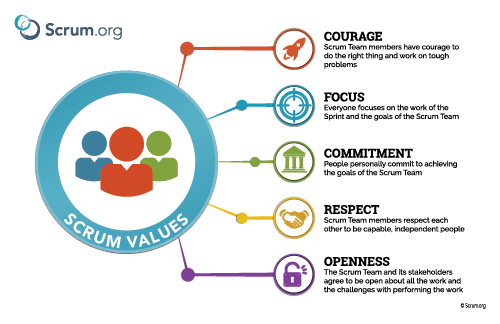Agile and Scrum are guided by principles and values. The following are taken directly from the official Agile and Scrum documents.
Agile
The Agile Manifesto documents the key features of Agile, the values and principles guiding it.
The 4 Agile Values
We are uncovering better ways of developing software by doing it and helping others do it. Through this work we have come to value:
- Individuals and interactions over processes and tools
- Working software over comprehensive documentation
- Customer collaboration over contract negotiation
- Responding to change over following a plan
That is, while there is value in the items on the right, we value the items on the left more.

The 12 Agile Principles
We follow these principles:
- Our highest priority is to satisfy the customer through early and continuous delivery of valuable software.
- Welcome changing requirements, even late in development. Agile processes harness change for the customer’s competitive advantage.
- Deliver working software frequently, from a couple of weeks to a couple of months, with a preference to the shorter timescale.
- Business people and developers must work together daily throughout the project.
- Build projects around motivated individuals. Give them the environment and support they need, and trust them to get the job done.
- The most efficient and effective method of conveying information to and within a development team is face-to-face conversation.
- Working software is the primary measure of progress.
- Agile processes promote sustainable development. The sponsors, developers, and users should be able to maintain a constant pace indefinitely.
- Continuous attention to technical excellence and good design enhances agility.
- Simplicity–the art of maximizing the amount of work not done–is essential.
- The best architectures, requirements, and designs emerge from self-organizing teams.
- At regular intervals, the team reflects on how to become more effective, then tunes and adjusts its behavior accordingly.
Enterprise Agile Manifesto
I came across an interesting addition to the Agile Manifesto, for Agile Coaches:
For Agile Coaches to understand the principles that allow for enterprise agility to flourish.
Principles
- Identify Motive
We are clear in our purpose for embracing agility. Our unique and compelling reason will be clearly articulated and transparent across the whole organisation. - Challenge Beliefs
We challenge our beliefs that hold us back, enabling positive impact that creates the motivation to achieve anything. - Focus on your Customer
We believe for engaging our customers we strive for high quality and purposeful creations that lead to a better life for our customers. - Align Around Value
We believe value creation is at the heart of our existence. Focusing on meaningful alignment around value flow allows for the emergence of effective systems. - Emergence for Lasting Change
We will create an environment to foster the emergence of meaningful and lasting change. - Learning Attitude
We are encouraged to connect and grow, to give feedback to create life long learning opportunities. By learning continuously we will keep improving. - Respect the Journey
We acknowledge the past and embrace the future of our never ending journey, understanding that as we move forward we will gain knowledge and face obstacles in discovering and achieving our goals. - Overcome Inertia
Through continuous improvement and transparency we overcome resistance to prosper with no limits. - Human behaviours
People are the heart of our inspiration. We create experiences and safe environments that allows autonomy to support positive desired behaviours. - Coaching Sustainability
Organisational development is driven from within. Capabilities for coaching are inherently built and grown independently.
From Enterprise Agile Manifesto.
Scrum
The Scrum Guide refers to values in how it operates.
The 3 Scrum Pillars
Three pillars uphold every implementation of empirical process control: transparency, inspection, and adaptation.
- Transparency. Significant aspects of the process must be visible to those responsible for the outcome. Transparency requires those aspects be defined by a common standard so observers share a common understanding of what is being seen.
For example:
- A common language referring to the process must be shared by all participants; and,
- Those performing the work and those inspecting the resulting increment must share a common definition of “Done”.
- Inspection. Scrum users must frequently inspect Scrum artifacts and progress toward a Sprint Goal to detect undesirable variances. Their inspection should not be so frequent that inspection gets in the way of the work. Inspections are most beneficial when diligently performed by skilled inspectors at the point of work.
- Adaptation. If an inspector determines that one or more aspects of a process deviate outside acceptable limits, and that the resulting product will be unacceptable, the process or the material being processed must be adjusted. An adjustment must be made as soon as possible to minimize further deviation.
Scrum prescribes four formal events for inspection and adaptation:
- Sprint Planning
- Daily Scrum
- Sprint Review
- Sprint Retrospective

The 5 Scrum Values
When the values of commitment, courage, focus, openness and respect are embodied and lived by the Scrum Team, the Scrum pillars of transparency, inspection, and adaptation come to life and build trust for everyone.
Successful use of Scrum depends on people becoming more proficient in living these five values. People personally commit to achieving the goals of the Scrum Team. The Scrum Team members have courage to do the right thing and work on tough problems. Everyone focuses on the work of the Sprint and the goals of the Scrum Team. The Scrum Team and its stakeholders agree to be open about all the work and the challenges with performing the work. Scrum Team members respect each other to be capable, independent people.


